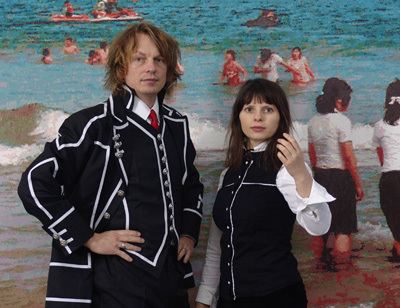 | ||
Römer + Römer (Torsten and Nina Römer) are a German-Russian artist couple living and working in Berlin, Germany.
Contents
Biography
Torsten Römer was born 1968 in Aachen, Germany. Nina Römer, née Tangian, 1978 in Moscow, Russia. Both studied painting at the Staatliche Kunstakademie (State Art Academy) Düsseldorf Academy under A. R. Penck and both were his master disciples. 1996 Torsten Römer received a travel grant from the Kunstverein Düsseldorf (Society of Arts). In 2011 they were bestowed with the special award of the Lucas Cranach Prize of the City of Kronach, Germany. Nina and Torsten have been collaborating since 1998.
Works
Römer + Römer employ photography, digital art, mixed media techniques, painting, make performances and curate shows. They are represented by Freight&Volume Galleries (New York), Kampl (Munich) und Michael Schultz (Berlin, Beijing, Seoul). In 1998 they commenced their “M°A°I°S” long-term art project. Their works often incorporate historical and political references: 2005 the Berlin show “Der freie Wille” (“The free will”) was part of the jubilee events for 20 years of “Glasnost”. And 2004 “HA KYROPT – Russische Kunst heute” (“Na Kurort [at the spa] – Russian Art Today”) in Baden-Baden related to the city's close ties with Russians spa-guests since the times of the Tsar. In such projects Römer + Römer do not come forth with an aesthetic analysis of historic-political situations yet they rather provide an aesthetic reconstruction. Their motifs are everyday scenes, mostly in the heightened form of festivities and parties. In a 2013/14 series they covered the carnival in Brasil ("Sambódromo"). Technically Römer + Römer set out from self-taken photographs which are subjected to image processing, the computer taking the traditional role of the sketchbook. The pictorial idea is then “handpainted” into “analogue images” with a pixel-structure. Thus the beholder of their landscapes and genre works simultaneously becomes the “user and consumer” of digital media. This way their Römer + Römer's art descends from the Impressionist movement of Pointillism and from stipple engraving, a favoured printing technique of the 18th century.
